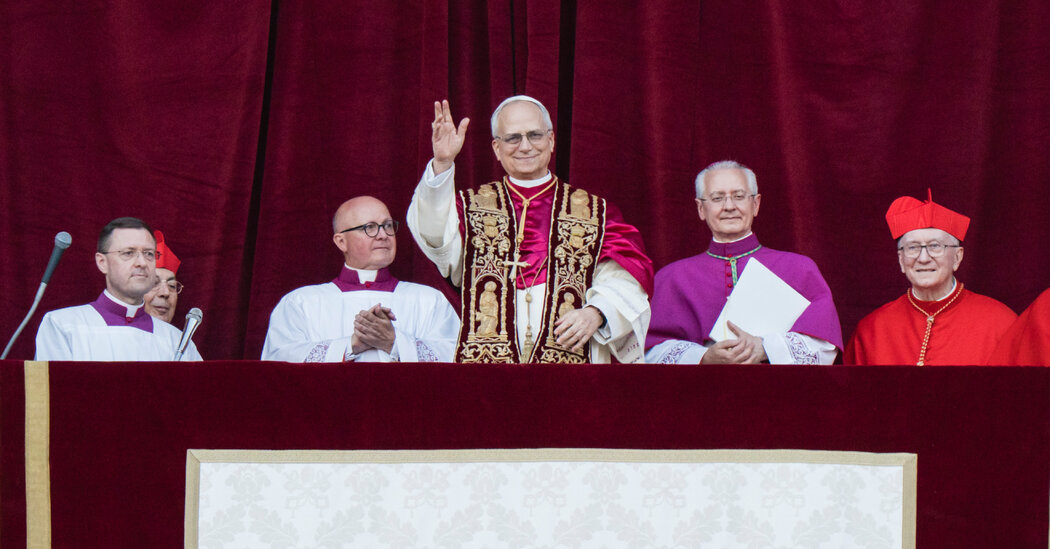The first American pope
Robert Francis Prevost was yesterday elected the 267th pope of the Roman Catholic Church, becoming the first pontiff from the U.S. He took the papal name Leo XIV and greeted a cheering crowd of followers at St. Peter’s Square by saying, “Peace be with you.” Read a transcript of his speech.
The choice defied a longstanding belief that church leaders would never select a pope from a global superpower that already has considerable influence. “In a world that seems upside down, old taboos are also breaking in the Vatican, where the idea of an American pope was unimaginable for generations,” Jason Horowitz, our Rome bureau chief, said.
See the moment Leo XIV emerged as pope.
As ideological camps tussled before the conclave over whether to continue the inclusive agenda of the last pope, Francis, or return to a conservative doctrinal path, supporters had pitched then-Cardinal Prevost, 69, as a balanced alternative. In his first remarks to the crowd that had gathered in St. Peter’s Square, Leo put great emphasis on the need to build bridges.
His election was greeted with rejoicing in Vatican City but also in Chicago, where he was born, and in Peru, where he spent more than two decades. President Trump called his selection “a great honor” for the United States.
Who is Leo? Born in Chicago, the 69-year-old pontiff spent much of his life outside the U.S. He served as missionary, parish priest, teacher and bishop in Peru, eventually becoming a Peruvian citizen. Until the death of Francis, he held one of the most influential Vatican posts, running the office that selects and manages bishops globally. Here’s what else we know about him.
What’s next: Leo will celebrate Mass at the Sistine Chapel today with the cardinals who elected him. He will recite a prayer on Sunday at St. Peter’s Basilica. And on Monday, he will meet with journalists at the Vatican.
For more:
Trump’s trade deal with Britain left details to be settled
The U.S. and the U.K. intend to sign a trade deal that would increase market access for billions of dollars of U.S. exports and also roll back some of the punishing tariffs on British products, President Trump said yesterday. It was the first agreement that the Trump administration has reached since imposing higher tariffs on its trading partners.
Representatives from the two nations will meet in the coming months, and many details are still to be worked out. The 10 percent tariff that Trump imposed in April on Britain and other nations will remain in place, but tariffs will be pared back on British steel, aluminum and automobiles. In return, Britain will open up access to beef, ethanol and other U.S. products.
The news is a much-needed political victory for Prime Minister Keir Starmer of Britain, as well as vindication of his strategy of assiduously cultivating Trump.
Context: Whatever the final deal ends up being, it may be more important to Britain than to the U.S. Britain occupies the No. 11 spot among major trading partners of the U.S., while the U.S. is Britain’s largest partner.
Who’s next?: E.U. officials drew up a list of 95 billion euros worth of U.S. goods that they could target with higher tariffs. Hours later, Trump said U.S. officials “intend to make a deal” with Europe. A first round of U.S.-China trade talks is expected to take place this weekend in Switzerland.
Danger grows in South Asia
India and Pakistan appear to be dangerously escalating their armed confrontation. Both countries said that their military sites had come under attack, and heavy shelling and strikes were reported overnight on each side of their border.
Secretary of State Marco Rubio spoke with leaders from both countries and emphasized the need for “immediate de-escalation,” the State Department said.
On the ground: In Jammu, an Indian city of about half a million people, parts of the city were under blackouts last night, and the sounds of blasts and sirens could be heard.
Strategy: India is working to restrict Pakistan’s access to international financial aid.
MORE TOP NEWS
Salads seem to have become a bit unwieldy. Cylindrical towers of romaine or layers of chicory are a way for chefs to maintain textural integrity and add a little pageantry — but the spectacle doesn’t always make for smooth eating. It’s enough to leave you asking, as one diner did, “Why am I cutting lettuce like a steak?”
CONVERSATION STARTERS
ARTS AND IDEAS
The museum of the century
Tate Modern in London, which turns 25 this week, made its greatest impact by re-envisioning itself as a theme park as well as a museum, transforming audience expectations worldwide, our critic Jason Farago writes.
Once the country’s most popular visitor attraction, the glory has faded. Visitor numbers are down 20 percent since before the pandemic, and funding crises have led to multiple rounds of layoffs. Is there a pathway back?
That’s it for today’s briefing. See you next week. — Natasha
Reach Natasha and the team at briefing@nytimes.com.











